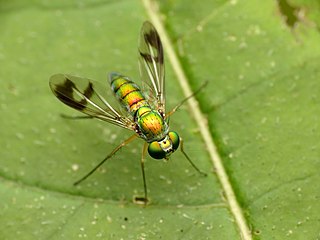Abatetia is a genus of flies in the family Dolichopodidae. It contains a single species, Abatetia robusta, and is found in New Zealand. The genus was originally known as Nelsonia, named by Octave Parent in 1933. The genus was then transferred to Cymatopus by Parent in 1937. Separately, David Miller found the name Nelsonia to be preoccupied by Nelsonia, and renamed it to Abatetia in 1945. However, the genus remained a synonym of Cymatopus until 1984, when it was restored as a separate genus by Henk J. G. Meuffels and Patrick Grootaert. Due to Nelsonia being preoccupied, Abatetia became the name of the genus.
Abbemyia is a genus of flies in the family Dolichopodidae, known from Australia and New Caledonia. It is named after the French entomologist Abbé Octave Parent, who studied the family Dolichopodidae.
Brevimyia is a genus of flies in the family Dolichopodidae. It contains only one species, Brevimyia pulverea, and is found in New Zealand. It was originally known as Brachymyia, named by Octave Parent in 1933. Later, David Miller found the name to be preoccupied by Brachymyia, and renamed it to Brevimyia in 1945.

Condylostylus is a genus of flies in the family Dolichopodidae. It is the second largest genus in the subfamily Sciapodinae, with more 250 species included. It has a high diversity in the Neotropical realm, where 70% of the species occur.
Dytomyia is a genus of flies in the family Dolichopodidae. It is known from Australia, Madagascar and Kenya, with an undescribed species from Papua New Guinea.
Halteriphorus is a genus of flies in the family Dolichopodidae. It is known from New Zealand, and contains only one species, Halteriphorus mirabilis.
Heteropsilopus is a genus of flies in the family Dolichopodidae.
Krakatauia is a genus of flies in the family Dolichopodidae.

Liancalus is a genus of flies in the family Dolichopodidae. It contains at least 21 species distributed worldwide except in Australasia and Oceania. The genus includes some of the largest species in the family, with body length approaching 12 mm in some species.
Mesorhaga is a genus of flies in the family Dolichopodidae.
Metaparaclius is a genus of fly in the family Dolichopodidae. It is known from Papua New Guinea and Australia.
Narrabeenia is a genus of flies in the family Dolichopodidae found in Australia. It is named after Narrabeen, New South Wales.
Negrobovia is a genus of flies in the family Dolichopodidae found in Australia. It is named in honor of O.P. Negrobov.
Pilbara octava is a species of fly in the family Dolichopodidae from Australia, and the only member of the genus Pilbara. The genus is named after the Pilbara region of Western Australia, where P. octava was found. In particular, the only known location of P. octava is at Millstream, Fortescue River.
Plagiozopelma is a genus of flies in the family Dolichopodidae.
Yumbera is a genus of flies in the family Dolichopodidae, known from eastern mainland Australia and Tasmania. The generic name is an Australian aboriginal word meaning "fly".

Hydrophorinae is a subfamily of flies in the family Dolichopodidae. Several studies have found evidence that the subfamily in its current sense is polyphyletic.

Sympycninae is a subfamily of flies in the family Dolichopodidae.
Nothorhaphium is a genus of flies belonging to the family Dolichopodidae. It includes four species from Australia and a single species from New Guinea.



